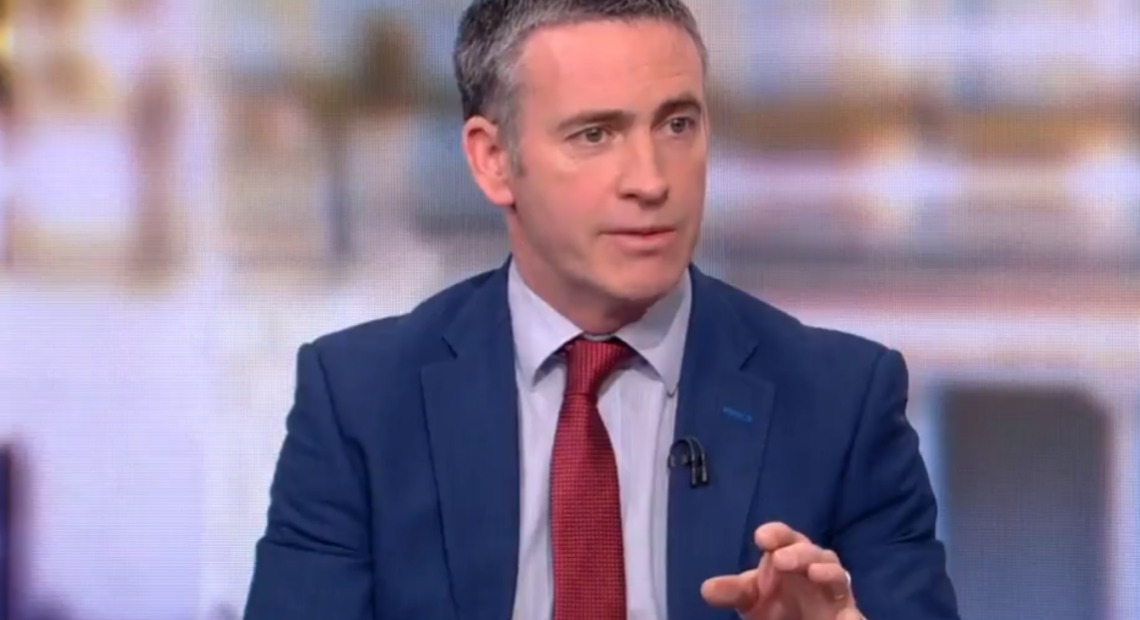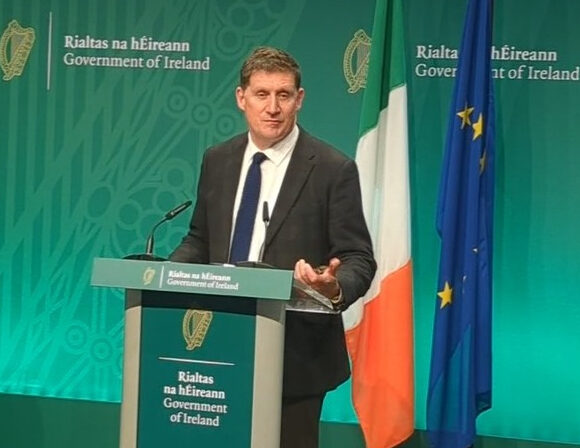There has been a lot of discussion in this House this week on housing and Rebuilding Ireland and unfortunately a lot of inaccurate and generalised commentary, from many of my colleagues across the floor.
I think we all saw through the political stunt that was pulled here, last Tuesday evening. All I can say is that it is disappointing that some members of this House choose to use the challenging and difficult circumstances, that some families and individuals find themselves in, to score political points rather than to put forward solutions that can help those households who are experiencing homelessness and housing issues.
I would like, today, to clarify some of the factual inaccuracies that we heard earlier this week and to talk about the homes this Government and Rebuilding Ireland are concerned with.
At the very core of Rebuilding Ireland is the objective of accelerating the delivery of social, affordable and private housing, while also supporting families and individuals, who are currently experiencing homelessness, or who may be at risk of homelessness in the future.
We have been working tirelessly to rebuild sufficient capacity in the housing market and as 2019 draws to a close, I think it is an opportune time to outline the progress that has been made and to inform the House of some future areas of priority action.
Homelessness
Addressing homelessness continues to be a key priority for this Government and for my Department in particular. We are working very closely with local authorities and our NGO service delivery partners to deliver solutions for those individuals and families experiencing homelessness.
While we are unfortunately seeing more individuals in emergency accommodation, it is worth noting that between October 2015 and October 2016, the numbers of individuals in emergency accommodation increased by 34%.
Between October 2018 and October 2019, an 8% increase was recorded. For families, there was an increase of more than 50% in the numbers in emergency accommodation between October 2015 and October 2016. Between October 2018 and October 2019, a 1.4% increase was recorded.
The Quarterly Performance Reports published by Minister Murphy showed that more adults, families and their children are moving from homelessness to a home and the rate of exit is increasing.
In the first nine months of the year, 4,389 adults, along with their associated dependents, left homelessness and moved to a home – a figure 17% higher than for the first nine months of 2018.
In Dublin, where 75% of families experiencing homelessness are located, 786 families moved from emergency accommodation to a home in the first nine months of the year – a 50% increase on the same period in 2018.
Nearly half the families presenting to homelessness services in the Dublin region were found a home without ever having to enter emergency accommodation.
Indeed, this year we will see record numbers exiting homelessness and it is important to note that since Minister Murphy took office in 2017, over 12,000 adults their children, exited homelessness into tenancies.
No person or individual should ever have to sleep rough. This has been a key priority of this Government and it is why over 350 new emergency beds were added this year in the Dublin Region to the other 800 emergency beds that were put in place since Rebuilding Ireland was published.
Last week, an Official Winter Rough Sleeper Count was carried out and a total of 92 persons were confirmed as rough sleeping across the Dublin region on that night. There were plenty of spare emergency beds in the region that night and shelter was available to any person who wished to have it.
This is the lowest figure for a winter rough sleeper count since 2015 and a 41% reduction on last year’s winter count. Homelessness we all know is a complex issue and that is why we will continue to work with the 92 individuals who are rough sleeping with a view to ensuring that the right health and housing supports are being provide to them. Ongoing engagement is support is provided by the Dublin Street Outreach Service, operated by Dublin Simon Community since 1 June 2019.
Through the Housing First programme, we are also delivering permanent sustainable homes for rough sleepers and long-term users of emergency accommodation. Housing First provides homes for homeless people with complex health needs, primarily in addiction and mental health, and includes the visiting health supports they need to stay in their homes. The National Implementation Plan for Housing First was published in September 2018 and includes targets for every local authority in the period 2018 -2021. Housing First will allow us to eliminate rough sleeping in many areas of the county. For example, Waterford City has informed my Department that Housing First has reduced rough sleeping in Waterford from 20 individuals to three people this month.
Other critical ongoing activities include:
* The Housing Assistance Payment, and a specific Homeless HAP service is playing a very important role in accelerating exits from homelessness. To the end of Q2 2019, some 9,000 households have been supported by the Homeless HAP scheme nationally.
* Budget 2019 provided an allocation of €146m, an increase of over 25% on the 2018 allocation, for the provision of homeless services by the local authorities.
This funding will increase to €166m in 2020 and will ensure that the local authorities can provide the best possible supports to those individuals and families experiencing homelessness, until they can be supported to move to a home.
* Where families do require emergency accommodation, we are working to minimize the use of hotels and have been delivering family hubs, to provide a more suitable form of accommodation. Not alone are the facilities more suited to maintaining a normal family dynamic but those families staying in hubs have been proven to exit to a permanent tenancy much sooner than would be the case in other forms of emergency accommodation. There are now 30 hubs operational nationally, offering almost 690 units of family accommodation in key urban housing authorities. We recognise that supporting an exit from homelessness sometimes requires more than a house; sometimes it requires a broader suite of social and welfare supports.
A number of Government Departments and Agencies are responsible for providing supports to homeless individuals and families. The Department of Health and HSE, in particular, have a key role in supporting the many individuals with health needs.
The Department of Children and Youth Affairs and Tusla have a central role in supporting families in Children. In September 2017, Minister Murphy established the Homelessness Inter-Agency Group to a coordinated and cohesive Government response to homelessness.
Housing Supply
The numbers of new homes becoming available for use in the year to end Q3 2019 was 23,554. This is a 15% increase when compared to the year to end Q3 2018, and a very positive endorsement of all the work that is being done to ensure that our housing supply is increasing.
17,995 new homes were built in 2018, which was a 25% increase on 2017 and the highest number of newly built homes in any year this decade.
The rolling annual total for new dwelling completions breached 20,000 units for the first time since this decade with the publication of Q3 2019 data. At the same time in 2018 the rolling annual total was just over 17,000 units.
Some 64,000 new dwellings have been completed since the launch of Rebuilding Ireland in 2016 and the supply of new homes will continue to increase.
At end June this year CSO data shows that over 30,000 new homes were granted planning permission. This is the first time that the annual total has exceeded 30,000 since early 2010.
As Ireland continues to progress towards delivering the levels of housing supply we need, the Government is also committed to ensuring that the supply of affordable and social housing is in a similar upward trajectory.
None of this happened by accident. Reforms around planning, land, building standards and finance have supported this delivery.
Social Housing Delivery
In terms of social housing delivery, we are continuing to build on the significant progress made between 2016 and 2018 in terms of supporting new households into homes.
Statistics for social housing delivery show that in the first six months of this year, over 12,100 homes were provided to families and individuals across Ireland.
This includes more than 2,550 additional social homes provided by local authorities and AHBs under build, acquisition and leasing programmes. At end Quarter 2 2019 there were over 6,400 homes on site; 22,000 homes in the construction pipeline, up more than 8% on Q1 2019. Taking into account Part V delivery, we expect over 6,000 social housing homes to be built this year.
By June of this year, some 84,000 additional eligible households had been supported by the taxpayer in to a home under a social housing support and we are on track to achieve 100,000 households by year-end.
The 2019 Summary of Social Housing Assessment is currently being compiled by the Housing Agency. According to provisional estimates, we expect that it will show that the numbers on the social housing waiting list continue to decline, with an estimated 25% reduction since 2016, when there were 91,600 households on the waiting list.
But supply is everything, and my Department is in constant contact with local authorities and approved housing bodies to achieve maximum output.
This year, in addition to regular ongoing contact, we have held a Housing Summit with local authority Chief Executives and 7 Regional events with local authority housing delivery teams.
New build is a key focus. Last year, we achieved 97% of the national target for new build activity. This year’s targets are even higher. All stakeholders acknowledge that with build output heavily generally weighted into the last 2 quarters of the year, there can be no room for complacency or slippage to make sure targets are met.
Affordable Housing and the Serviced Sites Fund
Both Minister Murphy and I have been clear that we need to help address issues of housing affordability and are cognisant of the significant pressure on lower- to middle-income households. This pressure is heightened further in Dublin and other urban centres throughout the country and this Government is committed to delivering genuinely affordable housing.
We committed €310 million up to 2021 under the SSF. This fund is for key facilitating infrastructure, on public lands, to support the provision of more affordable homes to buy or to rent.
A maximum amount of SSF funding of €50,000 will be made available per affordable home. On this basis, at least 6,200 affordable homes can be facilitated by this measure alone.
In Boherboy in Cork, work has started on 116 affordable homes for purchase. The first phase will be ready in the 3rd quarter of 2020. Prices will range from €198,000 to €223,000.
A couple earning €55,000 will be able to draw down a Rebuilding Ireland Home Loan to purchase these properties.
To date, funding of €127 million has been approved in principle to provide infrastructural work that will support 35 projects in 14 local authorities, delivering over 3,200 homes to buy or rent at prices which are significantly discounted on market norms.
Funding of €200million has also been made available under the Local Infrastructure Housing Activation Fund (LIHAF), which is also designed to activate housing supply by putting in place the enabling public infrastructure necessary to ensure that large scale development could take place on key sites in urban areas of high housing demand. 30 projects have been approved under this fund and will stimulate development of approximately 20,000 housing units and approximately 7,800 of these homes will be offered at a discount on open market prices.
Cost Rental
Under the Cost Rental model, rents cover the cost of delivering, managing, and maintaining the homes only, less both the profit margin seen in the private rental sector and any financial supports provided by the State/local authorities. With the resulting rents significantly below market levels, this means that many households on moderate incomes will have access to a more affordable and stable form of rental tenure than would otherwise have been the case.
The first cost rental project at Enniskerry Road went on site earlier this year. While the cost rental element of this project is relatively small in scale (50 units), it will act as the first example of how this model can work in an Irish context, and will provide us with invaluable lessons when designing a larger-scale system. It will help to shape the contractual model and specifications for future larger-scale projects.
The second Cost Rental pilot project will be delivered on a Dublin City Council-owned site at St. Michael’s Estate, Emmet Road, Inchicore. It is estimated that this site can accommodate over 470 homes in a high quality mixed tenure development.
The current tenure mix as agreed with the Department will be 70% Cost Rental and 30% Social.
In addition to these pilot programmes, the LDA is examining the potential to deliver Cost Rental homes at scale from its land portfolio and the broader State land bank, at sites such as the former Central Mental Hospital in Dundrum and Shanganagh in Dun Laoghaire.
These schemes complement other key Government affordability initiatives, such as the Rebuilding Ireland Home Loan, and the Help to Buy Scheme, which have supported some 16,500 households, with €563 million available to first time borrowers through the Rebuilding Ireland Homeloan for the period from February 2018 to the end of 2019, a very significant expansion of the original allocation of €200million over three years.
The new measures also complement the existing supply-side measures introduced under Rebuilding Ireland, such as fast-track planning reforms and more flexible planning guidelines, including updated planning guidelines in relation to building heights and apartments sizes and State land management initiatives, which are now having a positive impact on supply and are also contributing to the moderation in house prices.
Vacancy Pillar 5 of Rebuilding Ireland, sets out a range of measures to assist in meeting Ireland’s housing needs by ensuring that Ireland’s existing housing stock is used to the greatest extent possible. A survey conducted by the local government sector has indicated that, within participating local authorities, average long-term vacancy level ranges from 1.1% to 5.2%.
The National Vacant Housing Reuse Strategy, published on 26th July 2018, contains a range of objectives and key actions which will be pursued in partnership with stakeholders and agencies across the housing sector to address vacancy in our housing stock. As part of this local authorities were requested to draw up Vacant Homes Action Plans (all 31 completed) to identify the scale of vacant homes in their administrative areas, to set ambitious but realistic targets of the number of vacant homes can ultimately be brought back into use, whether for private sale/rent or for social housing purposes. To assist with this work my Department secured funding for each local authority to support the work of a Vacant Homes Office.
Land Development Agency
The Land Development Agency, which was established last year, will provide a new implementation mechanism for Project Ireland 2040 and the transformation of our key cities and towns; and will also strategically manage public lands and achieve public policy objectives, including the delivery of more housing in the locations that need it most and focusing on affordability.
It has an immediate focus on managing the State’s own lands to develop new homes, and regenerate under-utilised sites and has access to an initial tranche of 8 sites across the country that have near term delivery potential for 3,000 new homes.
Of these, at least 40% are intended for delivery as additional social and affordable homes and the balance as additional new supply to meet the high levels of demands in the wider housing market. Some 60% of all homes on the first four sites the LDA will develop will be social or affordable.
Significant preparatory work is underway in relation to these and it is envisaged that construction activity will commence on the first homes in mid-2020 for delivery by the end of that year, pending grant of planning permissions.
The LDA is also developing a strong pipeline of additional publicly owned sites. Departments were requested, in respect of lands owned directly and by agencies under their aegis, to identify additional lands over and above the initial eight sites.
The development of LDA managed lands will make a substantial contribution to the achievement of wider Government targets for housing delivery in general and social housing specifically.
Strategic Housing Developments
The Strategic Housing Development (SHD) arrangements introduced a new fast-track planning process to enable planning applications for large-scale housing developments (100 units or more) to be made directly to An Bord Pleanála (the Board) for determination and these arrangements have also made a real difference to delivery on the ground and we are seeing many homes come through this process. The SHD provisions have been extended by Minister Murphy until 2021, and work is also underway to implement a ‘use it or lose it’ provision, where work on SHD sites will have to begin within 18 months of the planning permission being granted. This is designed to ensure that homes are built as quickly as possible.
Renters
A range of measures have also been introduced to help and protect people renting their homes. The Residential Tenancies (Amendment) Act 2019 was signed into law this summer and is the most significant reform of the rental sector in recent years.
Building on the introduction of Rent Pressure Zones, it introduced longer notice to quit periods to protect tenants, extensive investigative powers for the Residential Tenancies Board and sanctions for landlords, along with regulation of short-term lettings.
My department is closely monitoring the rental sector to ensure the reforms are working.
Conclusion
I have spoken about some of the innovative, proactive and intensive work that has been advancing under and in parallel with Rebuilding Ireland.
Tackling the current housing situation is not a simple or straightforward task, and actions taken and new measures and legislation developed take time to show results.
I believe that these endeavours are now showing fruits as evidenced in the statistics. This Government is keenly aware that progress must continue to be made across the board to restore stability and sustainability to the Housing sector in Ireland, and is working tirelessly with our partners, the local authorities to achieve this.
This Government is also very aware that a one size fits all does not work in terms of the provision of housing and that is why Rebuilding Ireland provides solutions for all – young people, students, families, older people, people with a disability and people living in urban and rural communities.
This Government will continue to deliver solutions and homes for all citizens. This is not a time for the rhetoric and noise from across the floor of this House. It is about solutions, serving the public and rolling the sleeves up to support and help households into homes.
I reiterate that Housing is a key priority for this Government and we will continue our work.













